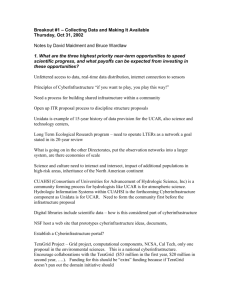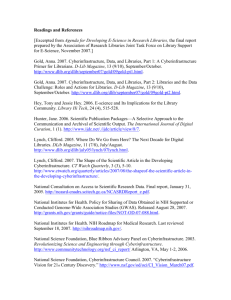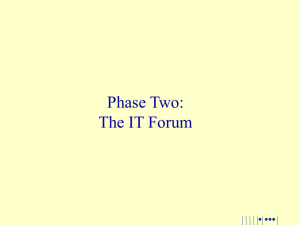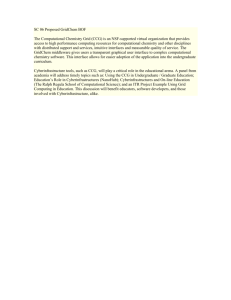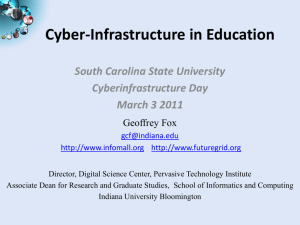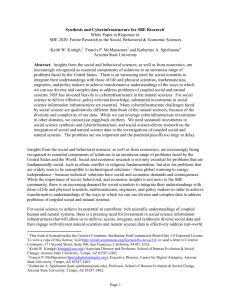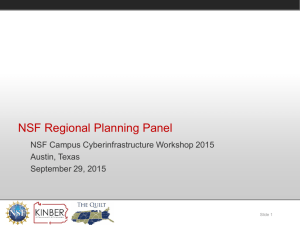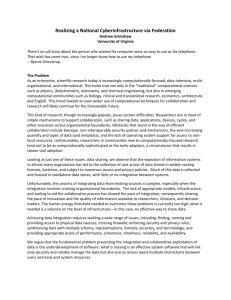CyberInfrastructure
advertisement
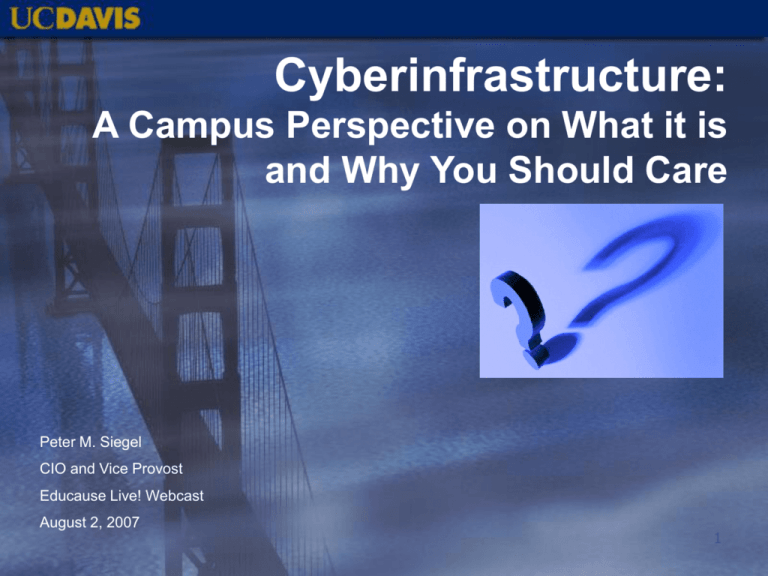
Cyberinfrastructure: A Campus Perspective on What it is and Why You Should Care Peter M. Siegel CIO and Vice Provost Educause Live! Webcast August 2, 2007 1 Cyberinfrastructure: A Campus Perspective on What it is and Why You Should Care Peter M. Siegel CIO and Vice Provost Educause Live! Webcast August 2, 2007 What is it? Why do we care? What do we do about it now? 2 Definitions Cyberinfrastructure (CI) Coined by the National Science Foundation (NSF) to characterize infrastructure based upon distributed computer, information, and communication technology, the newer term cyberinfrastructure was later popularized by the NSF Blue Ribbon Advisory Panel on Cyberinfrastructure. Report of the American Council of Learned Societies’ Commission on Cyberinfrastructure for Humanities and Social Sciences. 3 Definitions Knowledge Economy “The term infrastructure has been used since the 1920’s to refer collectively to the roads, power grids, telephone systems, bridges, rail lines, and similar public works that are required for an industrial economy to function. Although good infrastructure is often taken for granted and noticed only when it stops functioning, it is among the most complex and expensive things that society creates. The newer term cyberinfrastructure refers to infrastructure based upon distributed computer, information and communication technology. 4 Definitions Knowledge Economy “The term infrastructure has been used since the 1920’s to refer collectively to the roads, power grids, telephone systems, bridges, rail lines, and similar public works that are required for an industrial economy to function. Although good infrastructure is often taken for granted and noticed only when it stops functioning, it is among the most complex and expensive things that society creates. The newer term cyberinfrastructure refers to infrastructure based upon distributed computer, information and communication technology. “If infrastructure is required for an industrial economy, then we could say that cyberinfrastructure is required for a knowledge economy.” Revolutionizing Science and Engineering through Cyberinfrastructure: Report of the National Science Foundation Blue Ribbon Advisory Panel on Cyberinfrastructure, (Atkins Report), 2003. 5 Definitions Education, Commerce, Social Good “The emerging vision is to use Cyberinfrastructure to build more ubiquitous, comprehensive digital environments that become interactive and functionally complete for research communities in terms of people, data, information, tools, and instruments and that operate at unprecedented levels of computational, storage, and data transfer capacity. Increasingly, new types of scientific organizations and support environments for science are essential, not optional, to the aspirations of research communities and to broadening participation in those communities. They can serve individuals, teams, and organizations in ways that revolutionize what they can do, how they can do it, and who participates. 6 Definitions Education, Commerce, Social Good “The emerging vision is to use Cyberinfrastructure to build more ubiquitous, comprehensive digital environments that become interactive and functionally complete for research communities in terms of people, data, information, tools, and instruments and that operate at unprecedented levels of computational, storage, and data transfer capacity. Increasingly, new types of scientific organizations and support environments for science are essential, not optional, to the aspirations of research communities and to broadening participation in those communities. They can serve individuals, teams, and organizations in ways that revolutionize what they can do, how they can do it, and who participates. “This vision also has profound broader implications for education, commerce, and social good.” Executive Summary, page 2, Revolutionizing Science and Engineering through Cyberinfrastructure: Report of the National Science Foundation Blue Ribbon Advisory Panel on Cyberinfrastructure, (Atkins Report), 2003. 7 8 Definitions All areas of Inquiry “Cyberinfrastructure (CI) enables and supports scientific research through online digital instruments, emerging sensor and observing technologies, high- powered computers, extensive data storage capabilities, visualization facilities, and networks for communication and collaboration. The report of the Blue Ribbon Advisory Panel on Cyberinfrastructure (the “Atkins Report”) signals that the sum of these changes constitutes “a new age” which “has crossed thresholds that now make possible a comprehensive ‘Cyberinfrastructure’ on which to build new types of scientific and engineering knowledge environments and organizations and to pursue research in new ways and with increased efficacy.” Science and engineering are being transformed by Cyberinfrastructure. 9 Definitions All areas of Inquiry “Cyberinfrastructure (CI) enables and supports scientific research through online digital instruments, emerging sensor and observing technologies, high- powered computers, extensive data storage capabilities, visualization facilities, and networks for communication and collaboration. The report of the Blue Ribbon Advisory Panel on Cyberinfrastructure (the “Atkins Report”) signals that the sum of these changes constitutes “a new age” which “has crossed thresholds that now make possible a comprehensive ‘Cyberinfrastructure’ on which to build new types of scientific and engineering knowledge environments and organizations and to pursue research in new ways and with increased efficacy.” Science and engineering are being transformed by Cyberinfrastructure. This is just as true of the social, behavioral, and economic (SBE) sciences as of the physical, natural, engineering, and biological sciences. Francine Berman and Henry Brady, SBE/CISE Workshop on Cyberinfrastructure for the Social Sciences, May 2005. 10 Definitions Culture of Collaboration Campus cyberinfrastructure is not just about the technology. We need to understand and engage the research community, bridge the cultures, enhance the collaborative relationships on campuses and between campuses, and learn from each other. Ken Klingenstein, Kevin Morooney, Steve Olshansky. Final Report: A Workshop on Effective Approaches to Campus Research Computing Cyberinfrastructure. April 25-27, 2006 Arlington, VA. 11 NSF Cyberinfrastructure Vision for 21st Century Discovery “Final Version” March 2007 12 NSF Cyberinfrastructure Vision for 21st Century Discovery “NSF will play a leadership role in the development and support of a comprehensive cyberinfrastructure essential to 21st century advances in science and engineering research and education” 13 NSF Cyberinfrastructure Vision for 21st Century Discovery Five Areas Call for Action (Vision for 2006-2010) HPC Data, Data Analysis, and Visualization Virtual Organizations for Distributed Communities Learning and Workforce Development 14 NSF Cyberinfrastructure Vision The Mission Develop human-centered CI driven by research and education opportunities Provide world-class CI tools and services in all five key areas Promote a CI that broadens participation and strengthens the nation’s workforce in all areas of science and engineering Provide a sustainable CI- secure, efficient, reliable… that [is] an essential national infrastructure Create a stable but extensible CI environment 15 Learning and Workforce Development NSF Cyberinfrastructure Vision for 21st Century Discovery March 2007. 16 Cyberinfrastructure Functions and Resources Instrumentation Control Help Desk Researcher Security Viewing Data Generation Program Security Collab Tools Control Training Education And Outreach Publishing Policy and Funding Management Security and Access Access Control Human Support Funding Agencies Authentication Resource Providers Campuses Authorization Security Security Analysis Simulation Computation Program Input Archive Retrieval Data Sets Storage Search 3D Imaging Display Tools Data . Input Security Display and Visualization Data Directories Schema Metadata Ontologies Russ Hobby, Internet2 17 The Network is the Backplane for the Distributed CI Computer Training Instrumentation Help Desk Researcher Control Security Data Generation Human Support Viewing Program Collab Tools Control Education And Outreach Publishing Security Policy and Funding Management Security and Access Access Control Funding Agencies Authentication Resource Providers 3D Imaging Display Security Tools Campuses Authorization Security Security Analysis Simulation Computation Program Input Archive Retrieval Data Sets Storage Data . Input Search Data Directories Schema Metadata Ontologies Network Display and Visualization Russ Hobby, Internet2 18 Campus IT Network Security ID Mgmt Cyberinfrastructure Players Faculty National Data Center Security/ Access Discipline Groups Regional Libraries Publishers Collections Organizations* International Software Development Supercomputer Sites* Policy*/ Leadership*/ Funding Medicine Regional Grid Orgs* Educational Organizations OGF National Computation Storage Staff Federal Agencies Coordinators* Network Providers* Discipline Support Grad Students Regional International National International Researchers* Physical Science Biological Science. Other Disciplines Discipline Groups* 19 * University Consortia & Systems Russ Hobby, Internet2 University of California IT Guidance Committee Multi-campus models for cyber-infrastructure planning 20 EDUCAUSE Cyberinfrastructure Summit 1. SUPPORT FOR RESEARCH - While most definitions of CI are broad, implying applications beyond the research community, research will be the driving force and engine for investment. There is rapid expansion of demand for a robust CI on campus to support research. 2. LEADERSHIP - Central IT organizations need to play a leadership role in the strategic planning for a robust CI on campus. 3. PRIORITY and FUNDING - Most central IT organizations did not see CI coming to the extent it has. Most institutions have not anticipated and planned for such a big shift. 4. STRATEGIES LONG TERM - A significant social problem with cyberinfrastructure is that it is predicated on sharing, interoperability, coordination, and (some) consolidation. Incentives and reward systems have to be explored and developed and encouraged. 5. STRATEGIES SHORT TERM - Much of the effort around cyberinfrastructure is looking for a consensus, when the reality is that there are competing approaches. 6. EDUCAUSE INVOLVEMENT - How can we help each other? 21 Some issues to ponder At what level should cyberinfrastructure services be provided? What is the appropriate campus role and investment in cyberinfrastructure? What is the appropriate role at the college level? At the research group level? In the multi-institutional research communities? How do you create the right incentives for collaborative behavior? What about cyberinfrastructure services? In what ways should a university support its researchers and students in the context of very large data management? What is the role of cyberinfrastructure planning beyond the research arena? How do we increase federal (and state) attention to the investment needs for cyberinfrastructure at the campus level? 22 Before I tell you the issues… First, how did I come up with these? Did I make them up? No! We had to talk to the faculty! But how? We had a cyberinfrastructure workshop 23 Before I tell you the issues… First, how did I come up with these? Did I make them up? No! We had to listen to the faculty! But how? We had a cyberinfrastructure workshop 24 Listening to the faculty… Let me recap our CI Days at UC Davis Our view of ourselves We have great scientists, scholars, engineers,… Our investments are behind where we want them We aren’t smarter, richer (!), more innovative Nor did we stay in a Holiday Inn Express But we do actively involve our faculty on a growing basis in CI planning 25 Cyberinfrastructure Days Program • CENIC Brian Court • EDUCAUSE Mark Luker • Internet2 Ken Klingenstein • Open Science Grid John McGee TeraGrid Scott Lathrop UC Davis Information and Educational Technology Rodger Hess Dave Zavatson UC Office of the President David Walker Russ Hobby <rdhobby@Internet2.edu> 26 CI DaysAreas of Major Findings Data Access and Use Awareness and Community Building Personnel and Technical Support Infrastructure: Space and Power Infrastructure: Networking Financial Support and Funding 27 Cyberinfrastructure and Community Dynamics Research Group Local Applications DMZ Shared and Standard IT Applications Agile, high innovation, Often high risk Phase Transition Moderately stable, Moderate to low risk Campus/College Shared IT Services Institutional Hurdles Information Technology Components Common CI Components Policies, Cost-sharing, Incentives Less agile, solid, low risk Modified by PMS for a “researcher view”. Source: P. Weill & M. Broadbent Leveraging the New Infrastructure: How Market Leaders Capitalize on IT, Harvard Business School Press, June 1998. Cited in Brad Wheeler, IT Governance. 28 Cyberinfrastructure and Community Dynamics Research Group Local Applications DMZ Shared and Standard IT Applications T I M E Agile, high innovation, Often high risk Phase Transition Moderately stable, Moderate to low risk Campus/College Shared IT Services Institutional Hurdles Information Technology Components Common CI Components Policies, Cost-sharing, Incentives Less agile, solid, low risk Modified by PMS for a “researcher view”. Source: P. Weill & M. Broadbent Leveraging the New Infrastructure: How Market Leaders Capitalize on IT, Harvard Business School Press, June 1998. Cited in Brad Wheeler, IT Governance. 29 How do we increase federal (and state) attention to the investment needs for cyberinfrastructure at the campus level? While funding agencies have worked wonders with their strong investments in information technologies at the research group and research community levels (within and among universities), their dollars go farther if they provide incentives for campus investment through seed money, costsharing requirements, and so on. How do we build consensus between funding agencies, campus administration, campus IT leadership, and the research community nationwide on the role of each group in supporting campus cyberinfrastructure investments? 30 Some issues to ponder 31 Some issues to ponder At what level should cyberinfrastructure services be provided? What is the appropriate campus role and investment in cyberinfrastructure? What is the appropriate role at the college level? At the research group level? In the multi-institutional research communities? How do you create the right incentives for collaborative behavior? What about cyberinfrastructure services? In what ways should a university support its researchers and students in the context of very large data management? What is the role of cyberinfrastructure planning beyond the research arena? How do we increase federal (and state) attention to the investment needs for cyberinfrastructure at the campus level? 32 Conclusions CI is about “high end” services that are now basic, but it’s much more than that It’s a range of technologies and services It’s not just the researchers’ problem, it’s everyone’s problem CI solutions will be built through collaboration, but must acknowledge unique requirements CIOs will be measured by what we do in this space 33 Conclusions CI is about “high end” services that are now basic, but it’s much more than that It’s a range of technologies and services It’s not just the researchers’ problem, it’s everyone’s problem CI solutions will be built through collaboration, but must acknowledge unique requirements CIOs will be measured by what we do in this space Let’s roll! 34 Thank You 35 Visualization in the KeckCAVES • An interdisciplinary collaboration between physical scientists and computer scientists • The project engages graduate students, faculty, researchers from multiple colleges • Requires space and most importantly technical support • Requires flexibility: the technical needs evolve as the project does Louise Kellogg, Chair, Geology, UC Davis 36 The ANGSTROM group (http://angstrom.ucdavis.edu/) is located in the Chemistry Department at UCD and headed by Prof. Giulia Galli. Its research activity focuses on the development and use of quantum simulation tools to understand and predict the properties and behavior of materials (solids, liquids and nanostructures) at the microscopic scale. Access to and management of robust and stable campus cyber- infrastructure are critical needs for the group. ANGSTROM Highlights: •Proposal "Water in confined states" selected to receive a 2007 DOE-INCITE award. •“Quantum Simulations of Materials and Nanostructures”: SciDAC grant awarded to UCD-led team in September 2006. •“Materials by design: applications to thermoelectrics”: DARPA-PROM grant awarded to UCD-led team in January 2006. •Agreement with IBM/Watson signed for use of BG/L supercomputer by Angstrom members •“First principles simulations of dielectric properties in nano-silicon”: INTEL grant awarded in February 2006. Work of Prof Galli, described by Louise Kellogg, Chair, Geology, UC Davis 37 Cyber Infrastructure and the Quality of Life S.J. Ben Yoo, ECE, UC Davis, UC Davis CITRIS Director 38 Genomics and Bioinformatics • New Genome and Biomedical Sciences Facility • $95 million, 225,000 square-ft building • Cross-cutting, leading-edge research in genomics, bioinformatics, biomedical engineering, pharmacology and toxicology, and other areas. From Segal DS et al. "Structure of Aart, a Designed Six-Finger Zinc Finger Peptide, bound to DNA." J. Mol. Biol. Aug 2006 S.J. Ben Yoo, ECE, UC Davis, UC Davis CITRIS Director 39 Cyber Infrastructure in Health Care and Telemedicine Overlay Photos: IEEE Spectrum, October 2006 S.J. Ben Yoo, ECE, UC Davis, UC Davis CITRIS Director 40 Data Integration and Sensor Networks • Management and Analysis of Environmental Observatory Data using the Kepler Scientific Workflow System, SDSC, UC Davis, OSU, CENS (UCLA), OPeNDAP • • standardize services for sensor networks, support multiple views, protocols COMET: Coast-to-Mountain Environmental Transect, UC Davis, Bodega Marine Lab, Lake Tahoe Research Center • study how environmental factors affect ecosystems along an elevation gradient from coastal California to the summit of the Sierra Nevada CEO:P--COMET: Coast-to-Mountain Environmental Transect CEO:P--Management and Analysis of Environmental Observatory Data Using the Kepler Scientific Workflow System CEOP/REAP CEOP/COMET S.J. Ben Yoo, ECE, UC Davis, UC Davis CITRIS Director 41 Re sol uti on Davis Campus Research Network Testbed 3D visualization machine_1 Virtual reality Lo w Mid ium Imaging Hig h Ver y Hig h Cluster and Grid Computing OXC Indi vid ual bas epa irs OXC OLS router OLS router Smart Classroom To Berkeley, Santa Cruz OXC To Sacramento, Merced 42 S.J. Ben Yoo, ECE, UC Davis, UC Davis CITRIS Director
